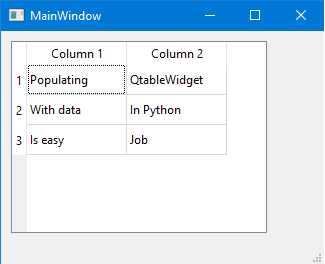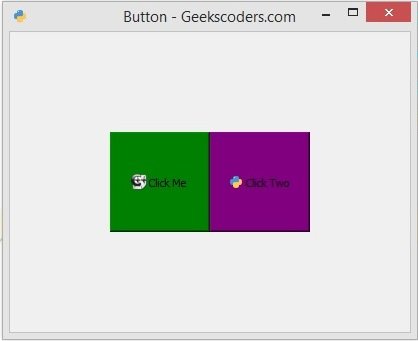Signals And Slots Pyqt5
1. Introduction of Signal Slot Mechanism
Signals And Slots Example Pyqt5
1. Introduction of signal slots
Signal slot is the core mechanism of Qt and also the mechanism of object communication in PyQt programming.In Qt, the QObject object and all controls in PyQt that inherit from QWidget support the slot mechanism.When the signal is transmitted, the connected slot function is automatically executed.In PyQt5, the signal and slot functions are connected by the object.signal.connect() method.
The characteristics of the signal slot are as follows:
(1) One signal can connect multiple slots
(2) One signal may connect another signal
(3) Signal parameters can be of any Python type
(4) One slot can monitor multiple signals
(5) The connection between signal and slot can be synchronous or asynchronous.
(6) Signal-slot connections can cross threads
(7) Signal can be disconnected
When writing a class, the signal and slot of the class are defined first, and the signal and slot are connected in the class to realize data transmission between objects.When an event or state changes, a signal is issued that triggers the execution of the slot function associated with the event or signal.The signal slot mechanism is illustrated as follows:
1 # Filename: signalsslots.py 2 3 'Signals and slots example.' ' 4 5 import sys 6 7 from PyQt5.QtWidgets import QApplication 8 from PyQt5.QtWidgets import QLabel 9 from PyQt5.QtWidgets import QPushButton 10 from PyQt5.QtWidgets import QVBoxLayout 11 from PyQt5.QtWidgets import QWidget 12 13 def greeting : 14 'Slot function.'
Sending Python values with signals and slots. On the #pyqt channel on Freenode, Khertan asked about sending Python values via Qt's signals and slots mechanism. The following example uses the PyQtPyObject value declaration with an old-style signal-slot connection, and again when the signal is emitted, to communicate a Python dictionary. For example, a signal&slot for making a signal&slot. App.exec run a loop but not run init over and over again. App.exec is waiting for user input, eventHandler, for example, keyPressEvent, mousePressEvent. Especially, paintEvent for showing the GUI. Init is only called once. The variables of it are allotted into your computer's. Although PyQt5 allows any Python callable to be used as a slot when connecting signals, it is sometimes necessary to explicitly mark a Python method as being a Qt slot and to provide a C signature for it. Signal slot is the core mechanism of Qt and also the mechanism of object communication in PyQt programming.In Qt, the QObject object and all controls in PyQt that inherit from QWidget support the slot mechanism.When the signal is transmitted, the connected slot function is automatically executed.In PyQt5, the signal and slot functions are connected by the object.signal.connect method.
2. Define the signal
PyQt's built-in signals are automatically defined, using the PyQt5.QtCore.pyqtSignal function to create a signal for a QObject object, and using the pyqtSignal function to define the signal as a property of a class.
The types parameter denotes the type of parameters that define the signal, the name parameter denotes the name of the signal, and the class's attribute name is used by default.
Use the pyqtSignal function to create one or more overloaded unbound signals as attributes of the class, signals can only be defined in subclasses of QObject.Signals must be defined at class creation time and cannot be added dynamically as attributes of a class after it is created.When a signal is defined using the pyqtSignal function, it can pass multiple parameters and specify the type of the signal transfer parameters, which are standard Python data types, including strings, dates, Boolean types, numbers, lists, dictionaries, tuples.
3. Operational signal
The connect function binds the signal to the slot function, the disconnect function unbinds the signal to the slot function, and the emit function emits the signal.
QObject.signal.connect(self, slot, type=None, no_receiver_check=False)
Establish the connection of signal to slot function, type is connection type.
QObject.signal.disconnect(self, slot=None)
Disconnect signal from slot
emit(self, *args)
Send signal, args is variable parameter.
2. Signal and Slot Application
1. Built-in signal and slot function
The built-in signal is the signal automatically defined by the QObject object, and the built-in slot function is the slot function automatically defined by the QObject object. The built-in signal of the QObject object can be connected to the slot function of the QObject object through the QObject.signal.connect function.
2. Built-in signal and custom slot function
When a button is clicked, the button's built-in clicked signal is triggered to execute the bound custom slot function onClose.
3. Custom signal and built-in slot function
By connecting the built-in signal clicked to the custom slot function onClose, a custom signal closeSignal is sent within the custom slot function onClose, and the custom signal closeSignal is connected to the built-in slot function close.
4. Custom Signal and Custom Slot Function
3. Advances in signal slot applications
1. Custom Signal Slot
Signal objects are usually defined through class variables, and custom signals are defined before u init_u functions.
The slot function definition of a class is the same as the general method definition of a class.
Signal and slot function can belong to the same QObject object or different QObject objects by connect ing signal and slot function.
The signal is sent by the emit method.
2. Signal slot transfer custom parameters
The number of parameters emitted by the signal in Qt must be greater than or equal to the number of parameters of the slot function. PyQt uses custom parameter transfer to solve the problem that there are more parameters in the slot function than in the signal.A Lambda expression or a functools partial function can be used to pass custom parameters to the slot function, which can be of any Python type.
3. Signal slots and ornaments
Signal and slot functions can be defined in PyQt using a Python decorator as follows:
The sender object name is the object name set for the QObject object using setObjectName, and the connectSlotsByName function connected to the slot function by the signal name is as follows:
QtCore.QMetaObject.connectSlotsByName(self, QObject)
ConneSlotsByName is used to connect certain signals of QObject descendant objects to corresponding slot functions of certain QObject objects by name.

4. Event handling mechanism
1. The difference between event mechanism and signal slot mechanism

PyQt provides a high-level signal slot mechanism and a low-level event processing mechanism for event processing, which is an advanced encapsulation of event processing mechanisms.When using a control, you don't need to consider the event handling mechanism, you only need to care about the signal slot. For a custom derived control, you must consider the event handling mechanism and re-implement the corresponding event handling function according to the behavior requirements of the control.
2. Method of event handling
PyQt provides five event handling and filtering methods:
(1) Re-implement event handling functions
Common event handling functions such as paintEvent, mouseMoveEvent, mousePressEvent, mouseReleaseEvent, and so on.
(2) Re-implement the QObject.event event distribution function
When adding new events, you need to re-implement the QObject.event method and add distribution routes for new events.
(3) Install event filters
If the installEventFilter method is called on a QObject object, an event filter is installed on the QObject object.All events of the QObject object are first passed to the event filter eventFilter function, in which certain events can be discarded or modified, custom event handling mechanisms are used for events of interest, and default event handling mechanisms are used for other events.Event filtering mechanism filters all events of QObject, so more events to filter can affect program performance.
(4) Install event filters in QApplication
Installing event filters on QApplication objects filters all events on all QObject objects and gets events first, which are sent to QApplication's event filters before sending them to any other event filters.
(5) Notfy method for QApplication
PyQt distributes events using the notify method of the QApplication object. The only way to capture events before any event filter is to re-implement the notify method of the QApplication.
3. Examples of event handling
The QDialog dialog automatically exits when the ESC key is pressed, and the ESC key is pressed using event handling and filtering.
(1) Re-implement event handling functions
(2) Re-implement the event function
(3) QObject Installation Event Filter
(4) QApplication Installation Event Filter
Posted by globalinsites on Sun, 21 Jul 2019 09:24:23 -0700
Build complex application behaviours using signals and slots, and override widget event handling with custom events.
As already described, every interaction the user has with a Qt application causes an Event. There are multiple types of event, each representing a difference type of interaction — e.g. mouse or keyboard events.
Events that occur are passed to the event-specific handler on the widget where the interaction occurred. For example, clicking on a widget will cause a QMouseEvent to be sent to the .mousePressEvent event handler on the widget. This handler can interrogate the event to find out information, such as what triggered the event and where specifically it occurred.
You can intercept events by subclassing and overriding the handler function on the class, as you would for any other function. You can choose to filter, modify, or ignore events, passing them through to the normal handler for the event by calling the parent class function with super().
However, imagine you want to catch an event on 20 different buttons. Subclassing like this now becomes an incredibly tedious way of catching, interpreting and handling these events.
Thankfully Qt offers a neater approach to receiving notification of things happening in your application: Signals.
Connect Signal And Slot Pyqt5
Signals
Instead of intercepting raw events, signals allow you to 'listen' for notifications of specific occurrences within your application. While these can be similar to events — a click on a button — they can also be more nuanced — updated text in a box. Data can also be sent alongside a signal - so as well as being notified of the updated text you can also receive it.
The receivers of signals are called Slots in Qt terminology. A number of standard slots are provided on Qt classes to allow you to wire together different parts of your application. However, you can also use any Python function as a slot, and therefore receive the message yourself.
Load up a fresh copy of `MyApp_window.py` and save it under a new name for this section. The code is copied below if you don't have it yet.
Basic signals
First, let's look at the signals available for our QMainWindow. You can find this information in the Qt documentation. Scroll down to the Signals section to see the signals implemented for this class.
Qt 5 Documentation — QMainWindow Signals
As you can see, alongside the two QMainWindow signals, there are 4 signals inherited from QWidget and 2 signals inherited from Object. If you click through to the QWidget signal documentation you can see a .windowTitleChanged signal implemented here. Next we'll demonstrate that signal within our application.
Qt 5 Documentation — Widget Signals
The code below gives a few examples of using the windowTitleChanged signal.
Try commenting out the different signals and seeing the effect on what the slot prints.
We start by creating a function that will behave as a ‘slot’ for our signals.
Then we use .connect on the .windowTitleChanged signal. We pass the function that we want to be called with the signal data. In this case the signal sends a string, containing the new window title.
If we run that, we see that we receive the notification that the window title has changed.
Events


Next, let’s take a quick look at events. Thanks to signals, for most purposes you can happily avoid using events in Qt, but it’s important to understand how they work for when they are necessary.
As an example, we're going to intercept the .contextMenuEvent on QMainWindow. This event is fired whenever a context menu is about to be shown, and is passed a single value event of type QContextMenuEvent.
To intercept the event, we simply override the object method with our new method of the same name. So in this case we can create a method on our MainWindow subclass with the name contextMenuEvent and it will receive all events of this type.
If you add the above method to your MainWindow class and run your program you will discover that right-clicking in your window now displays the message in the print statement.

Sometimes you may wish to intercept an event, yet still trigger the default (parent) event handler. You can do this by calling the event handler on the parent class using super as normal for Python class methods.
This allows you to propagate events up the object hierarchy, handling only those parts of an event handler that you wish.
However, in Qt there is another type of event hierarchy, constructed around the UI relationships. Widgets that are added to a layout, within another widget, may opt to pass their events to their UI parent. In complex widgets with multiple sub-elements this can allow for delegation of event handling to the containing widget for certain events.
However, if you have dealt with an event and do not want it to propagate in this way you can flag this by calling .accept() on the event.
Alternatively, if you do want it to propagate calling .ignore() will achieve this.
In this section we've covered signals, slots and events. We've demonstratedsome simple signals, including how to pass less and more data using lambdas.We've created custom signals, and shown how to intercept events, pass onevent handling and use .accept() and .ignore() to hide/show eventsto the UI-parent widget. In the next section we will go on to takea look at two common features of the GUI — toolbars and menus.